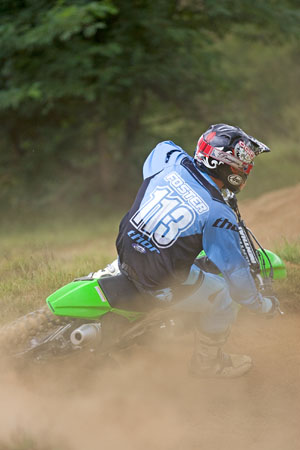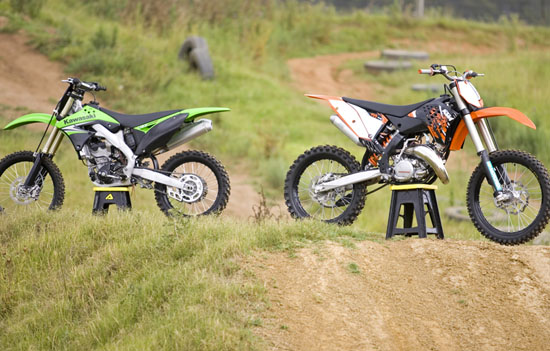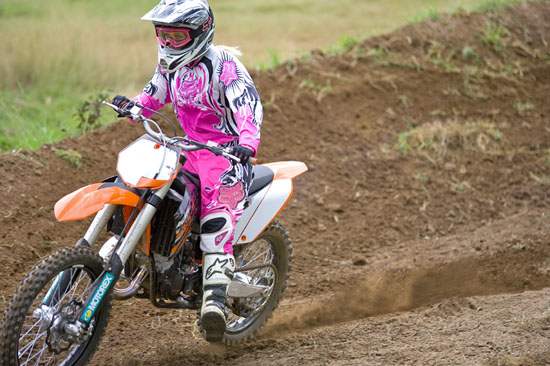The Australian magazine Dirt Action compared the KTM 150SX against the Kawasaki KXF250. The surprising aspect of the test is the difference between the test riders preferences and their lap times.
Many people claim that they are faster on a four-stroke than a two-stroke, but how many of them have actually used a stop watch and checked? And with this comparison they still allowed the four-stroke an almost 100cc advantage.
By: Ben Foster Photos By: Matt Bernard
• Engine: KTM: liquid-cooled, single cylinder, two-stroke / KXF: DOHC, four-valve, single-cylinder four-stroke
• Bore & Stroke: KTM: 56 x 58.5 mm / KXF: 77.0 x 53.6mm
• Fuelling: KTM: Carby / KXF: Carby
• Transmission: KTM: Six-speed / KXF: Five-speed
• Fork: KTM: WP USD 48mm / KXF: KYB USD 48mm
• Shock: KTM: WP PDS / KXF: KYB
• Weight: KTM: 90.8kg -claimed / KXF: 104.3kg claimed
• Price: KTM: $9795 / KXF: $10299
The Lites class (with bikes that are made up of up to 150cc two-strokes or 250cc four-strokes) is without doubt the most popular in motocross. Take a look at any club, state or national level race meeting and you’ll see the majority of entries are in the smaller capacity class. Why is this so? Well, the bikes are slightly cheaper to buy, but more importantly a hell of a lot easier to ride. Usually when things are easier, they are more fun.
Nine out of 10 of us a going to be faster on a Lites capacity bike, as the power is much more manageable and we’ll usually be able to ride it for longer periods of time. People often make the misconception though that less horsepower equates to slower lap times, which actually couldn’t be further from the truth. Worldwide, Lites bikes are setting as quick or often quicker lap times than riders in the Open class, because the rider can ride the bike to its potential and get a better handle on it.
Previously, the two-strokes in the Lites class have been represented by the “old faithful” 125cc machine. It’s been around for years and still a favourite of many the junior or smaller riders out there due to its light weight, quick handling and ease to start nature. While they’re still a ball to ride, the 125s have had little bit of trouble keeping up with the rapidly improving technology and performance of the 250cc thumpers, and are often the second choice when choosing between the two at the bike shop.
To offer the two-stroke fans out there a little extra, KTM has launched into the Lites class with a newer, bigger and beefier 125… actually, it’s a 150cc two-stroke. It’s got everything the same as a 125 with chassis, suspension and weight, but it’s just been given a few extra herbs to help take on the thumpers. DIRT ACTION tested the little rocket last issue and was so impressed with the package that we put it head-to-head with the 250F motocross shootout-winning Kawasaki KX250F.
Our plan was to not only see how the 150 fairs against the impressive KX-F, but to also show there are still other competitive options out there for people wanting something other than a four-stroke. Don’t get me wrong, four-strokes are great and undoubtedly the way of the future, but there are still a lot of advantages to owning a two-stroke.
The purchase price is often less and, while some maintenance is more frequent on the two-stroke (such as top end rebuilds), it’s usually considerably cheaper. For our test we assembled a range of five testers, all of whom would be potential buyers of both the bikes. Everyone from the featherweight junior to the battling girl, faster clubman-level riders and myself, the heavier-weighted expert. We gave each of the riders a day to thrash, bash and lap both bikes and see which one came up trumps. On top of that, we got quotes on some maintenance procedures on both bikes that are going to come up regularly.
One of DA’s regular test tracks, this stadium motocross-style track is tight, rough and of a reasonable length with plenty of jumps and a few good up and downhill switchback sections, while the surface is a mix of sand, loam and hard pack. We thought it was the best venue that would put both bikes on a fairly level playing field
With a win in DA’s very own 250F MX shootout, we had already discovered that the all-new KX250F is a cracker of a bike. With a stack of upgrades from the 2008 model, the 2009 version hits the track in a sleeker, better performing and better handling package.
The 250cc four-stroke is the class leading engine with a grunty bottom end that pushes through to a punchy and explosive mid-range. While there is more top end than last year, the power does shut off pretty early in the rev range and fights back with a burbling, odd-sounding rev limiter. The ergos have been slimmed down a fair bit from last year’s bike, but it’s still feels a touch wide through the knees and the peg/seat/bar relationship feels quite tall, even know the bars are quite a low bend.
The KX-F has killer looks with black rims, black number plates and a trick coating on the fork sliders, and has the aggressive exhaust bark to back up the looks. As far as 250Fs go, this bike is the duck nuts.
 GRANT – 17/Fast C-grader/70kg
GRANT – 17/Fast C-grader/70kg
The KX is great. It’s got awesome power with handling to match. The engine has a really strong bottom end and mid-range delivery and, on a tighter track like this one, you can really use it to your advantage. It prefers to be ridden smoothly though, and if I revved it too hard it ran out of puff up top. The stock suspension is pretty good for my weight and speed, and I reckon I could get it pretty good with just clicker adjustments.
DANE – 15/Junior/52kg
The KX feels a little firm for me. I was having a bit of trouble with the front end, as it felt pretty hard and the bars felt quite tall, which made it a touch uncomfortable for me and made it a little hard to steer. The engine is unreal though. It is really grunty and was awesome at getting out of the tighter corners. It seems to sign off a bit up top, but if I kept it in the meaty part of the mid-range, it was unreal.
Alisha – 20/Girl/63kg
I love the KX. It pulls unreal out of sandy and loamy corners, and is much better up the hills. One of the biggest things I noticed though was that it tracked straighter in the air over the jumps. It didn’t want to move around like the 150 did and it gave me a bit more confidence. The suspension is pretty firm though and kicked and bucked around a little. The engine is awesome, and the power is really easy to use.
Matt – 18/Clubman/83kg
I had fun aboard the KX. It has a strong engine down low, but it feel like it was starting to run out of revs up top and the limiter would kick in prematurely. I found myself trying to short shift to keep it in the strong part of the power, but within that part of the power it hauls arse! I struggled a little with the suspension, as it felt a tad unsettled under brakes and would push the front end around flat skatey corners. With a bit of fiddling by a suspension tuner I reckon I could get it handling pretty sweet which would offer me more confidence in the bike.
125s are a buttload of fun to ride, but one thing you always seem to be chasing with them is more horsepower. Now, with KTM’s production 150, that power is handed to you on a platter. It’s very similar to a 125 in all its characteristics. To get the most from it, you’ve gotta be up it. The little engine loves to scream and will put up with it all day. The extra 25cc gives it just that little bit more poke everywhere. It’s not like it’s got a turbo strapped to it or anything, more like the old 125 engine has had a trip to the factory race shop and given a dose of bottom end power with slightly more torque throughout the rev range and a bit more sting up top.
It’s just what the doctor ordered for the 125 and I reckon has the potential for a bit more yet. The whole bike literally feels small underneath you. The ergos are slim and everything feels low to the ground. On track, you can really notice the light weight, and are able to muscle it in or out of any situation with little effort. You’d still find it hard work grabbing a holeshot in a field of 250Fs, but that’s not to say it’s impossible.
DANE – 15/Junior/52kg
The KTM is really fun. The suspension is really nice and plush and it handles really well with no surprises anywhere. There is plenty of power on offer for a little bike, but you have to work a bit harder to get the most of it. There’s not much off the bottom, although there is more than a 125, but through the mid and top end of the rev range the power really comes to life. It feels quite small to ride, which makes it easier for me to muscle around or even pick up if I dropped it, and it’s heaps easier to start than a four-stroke.
Alisha – 20/Girl/63kg
I love the KTM. I’m used to riding a four-stroke so it took me a little bit to get the hang of it, but once I did, I loved it. The power is snappy and responsive and makes you want to ride it hard. With it being lighter, I think the bike is a fair bit easier for me to handle. I could pick it up in corners and change direction a little easier, although it did feel a little flighty over jumps. The suspension is well suited to my size and speed and it makes for a comfortable ride. Starting it was pretty easy once I got the knack of it.
Matt – 18/Clubman/83kg
The Kato is super fun. I really had to get up the thing and get it revving to get it pulling, but that’s what I enjoyed the most about the KTM – it was a real blast. The nimble package really makes it a weapon around the style of circuit we rode. I could easily move the bike around and put it exactly where I wanted it time and time again. I felt as though I did have to be a bit more on the ball and really thinking when riding the 150, trying to find the faster lines and keeping up my momentum rather than just cruising along.
Grant – 17/Fast C-grader/70kg
The KTM is awesome fun. It didn’t have a whole lot in the way of bottom end, but it was better than a 125. Once you got working with the clutch and could keep the power in the mid and top of the rev range, it was so much fun to ride. I felt like it may have been a little soft in the suspension for my weight and speed, and the whole package physically felt small, kinda like a big 85cc. Being small, you could really treat it mean and force it to be where you wanted, when you wanted, which makes for a good time.

Before the day came to a close, we asked each rider to give us their thoughts and choice out of the two bikes, then as soon as they had finished giving us the comments we sent them out to clock lap times on both bikes. Each of us had three attempts on both bikes and we picked the fastest on each. The results didn’t always match the choice of the rider and surprised a few of us when we saw the numbers.
Grant –
For a tighter track like the one we rode on today, I think I’d choose the KX-F. I feel like the extra bottom end and mid-range it offers would really help out. The power is smoother and requires less work, so I reckon I’d be in better shape come the end of a moto. If the track was a little more open, I’d love the KTM, it’s so much fun to ride, but takes a fair bit of work to make everything happen. Even know it’s lighter and smaller, there’s still a lot more juggling going on.
Dane –
I reckon I’d have to go with the KTM. For someone my size everything just seemed that bit more forgiving. It felt a lot smaller to ride, it was a lot lighter underneath me and I could pick it up or muscle it around a lot easier than the KX-F. The power is fun, and it was easier to keep it revving hard up the top than I thought. The KX-F is great, but it just felt a fair bit bigger and took a bit more work for me to control. I think the KTM wouldn’t be as physically tough on me over say 10 laps… I think I’d get arm pump and that quicker on the KX-F.
Alisha –
For the track we rode today, I think I’d pick the KTM. It was easier for me to get around the tighter sections and make corrections if I needed to and the power was fun and snappy. For tracks like AMCROSS or more open motocross, I’d go with the KX-F for sure. I reckon if there were softer berms or the surface was loose, it would be much better for me there as it would pull a little harder.
Matt –
Around this particular track, the Kato gets it for me. Although when it comes to racing a bike for a full season, I think I would still go for the Kawasaki. I feel a lot faster around here today on the KTM, but if there were a few more hills and some bigger acceleration bumps I think the tables would be turned. I also would worry a little about starts on the 150. Being over 80kg, the 250 has that extra grunt to pull off the line which can be important in the Lites class, as there are so many quick guys and all the 250Fs are so similar in power.
As I mentioned earlier, maintenance costs come into the equation on the smaller bikes, as the upkeep is often more frequent. We called a dealer for both manufacturers to get quotes on a top end replacement (piston and rings). As we said, the 150 may need it more frequently, while the KX-F will also need to take into consideration valves etc too. But, for comparison’s sake, here are the costings on top end replacements for both:
Kawasaki: $680 inc. parts and labour
KTM: $500 inc. parts and labour
Grant – Fast C-grader
KAWASAKI: 1:32.45
KTM: 1:31.06
Dane – Junior
KAWASAKI: 1:35.63
KTM: 1:33.66
Matt – Clubman
KAWASAKI: 1:34.64
KTM: 1:31.75
Alisha – Girl
KAWASAKI: 1:53.00
KTM: 1:56.03
Ben – Expert
KAWASAKI: 1:30.06
KTM: 1:29.56
http://www.dirtaction.com.au/_webapp_175362/2009_KTM_150SX_vs_Kawasaki_KXF250










